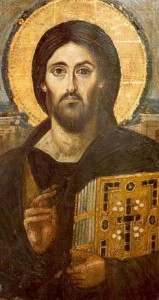
“Christ Pantocrator” is one of the earliest surviving icons of Jesus Christ. It dates from the early 500s (6th century AD) and is housed in the church at St. Catherine’s Monastery, Mount Sinai, Egypt. The Greek word pantocrator means “ruler of all.” The icon is painted with colored beeswax applied with spatula (encaustic technique) onto a wooden panel and measures 33 inches by 18 inches. In the icon image, Christ is robed in a purple tunic, a color which signifies royalty. He is holding a copy of the Gospels in his left hand while his right hand is raised in blessing. The icon depicts Jesus Christ as both Ruler of all, thus our Judge, and as Savior of the world who brings us the Gospel, the good news of salvation and life-giving Word of God. The face painted on the icon was most likely copied from the Image of Edessa (also called the Myron or Holy Mandylion), a rectangular piece of cloth with an image of the face of Christ on it, kept in the Greek city of Odessa in the 4th century, but has subsequently been lost. It was believed to be the rectangular piece of cloth that covered the face of Jesus for his burial. The facial image on the Shroud of Turin, which is believed to be the full burial shroud of Jesus, also matches the image of the face of Christ in the icon.—Excerpt from Christ Ruler of All By Don Schwager
CLICK HERE to read Christ as Pantocrator article
